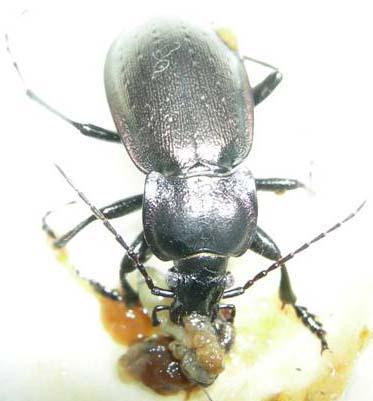Killer slugs vs. slug killers
Taxonomy, biology and natural enemies of the Iberian slug, Arion vulgaris

Hovedinnhold
Bjørn Arild Hatteland, Steffen Roth, continuing work from the late Torstein Solhøy
Invasive species are an increasing threat to today’s ecosystems that, in many cases, have been introduced by man. The Iberian slug Arion vulgaris (previously regarded as A. lusitanicus) is such an invasive species dispersing across large parts of Europe and doing considerable damage to gardens, horticulture and agriculture. It is likely that this slug has an impact on ecosystems by displacing or hybridising with native species such as the Black slug Arion ater. Thus, the invasive nature of the Iberian slug calls for research into its taxonomy, biology, and natural enemies.
Two projects funded by the Norwegian Research Council (NFR): “Preventive and direct management of the Iberian slug Arion lusitanicus in Norway”2005-2008 and “Elements in an integrated pest management protocol of the invasive Iberian slug, Arion lusitanicus, in agriculture” 2009-2012.
Aims:
- Clarify the status of Arion vulgaris and A. ater in Norway
- Detect and quantify predation by beetles and snails on A. vulgaris
- Investigate the lifecycle and population dynamics of A. vulgaris
- Explore the distribution of A. vulgaris in Norway
A combination of morphology and DNA is used to distinguish between the large Iberian slugs and potential hybrids. Population densities are estimated by quadrat surveys; counting and weighing slugs found in the vegetation down to the soil surface. Predation is studied using feeding experiments in the laboratory and in semi-field experiments. Predation is also studied by using DNA analyses to screen the gut contents of predators.
Research highlights
- Arion vulgaris is mainly distributed along the Norwegian coast up to Bodø in Nordland County north of the Polar Circle.
- Maximum densities of active A. vulgaris normally occur in spring (April-May), sometimes reaching an abundance of 60 slugs per square metre in grasslands and gardens.
- Arion vulgaris overwinters in Norway mainly as small juveniles and follows a one year lifecycle as known from continental Europe, mating in July-August and laying eggs in August-September.
- Two multplex PCRs including species-specific primers (genetic markers) were designed to differentiate Arion vulgaris, A. ater and A. rufus based on morphological and genetic characters.
- Carabid and staphylinid beetles feed on A. vulgaris as eggs or small juveniles, but only large carabid beetles (e.g. Carabus nemoralis) consume larger juveniles.
- Predation in the field by carabid beetles is most significant in spring and seems to be density dependent without any clear preferences between slug species.
A webpage about the project (in Norwegian) can be found here: snegler.bioforsk.no/
Collaborators: Arild Andersen (Bioforsk), Solveig Haukeland (Bioforsk), Christoffer Schander (UiB), Morten Skage (UiO), John Skartveit (NLA), William Symondson (Cardiff University), Leslie Noble (Aberdeen University), and Ted von Proschwitz (University of Gothenburg)
Key papers:
Hatteland, B. A., Roth, S., Andersen, A., Kaasa, K., Støa, B. & Solhøy, T. 2013. Distribution and spread of the invasive slug Arion vulgaris Moquin-Tandon in Norway. Fauna Norvegica 32: 13-26.
Hatteland, B.-A., Symondson, W.O.C., King, R.A., Skage, M., Schander, C. & Solhøy, T. 2011. Molecular analysis of predation by carabid beetles (Carabidae) on the invasive Iberian slug Arion lusitanicus. Bulletin of Entomological Research 101: 10.1017/S0007485311000034
Hatteland, B.A., Grutle, K., Mong, C.E., Skartveit, J., Symondson, W.O.C. & Solhøy. T. 2010. Predation by beetles (Carabidae, Staphylinidae) on eggs and juveniles of the Iberian slug Arion lusitanicus in the laboratory. Bulletin of Entomological Research 100: 559-567. doi:10.1017/S0007485309990629
Hatteland, B.A., Salvesen, P.H. & Solhøy, T. 2007. Strølagsforsøk med iberiaskogsnegl, Arion lusitanicus. Årringen 11: 109-110
